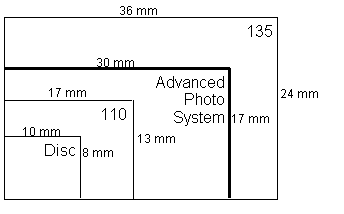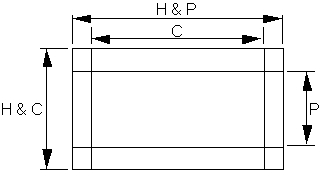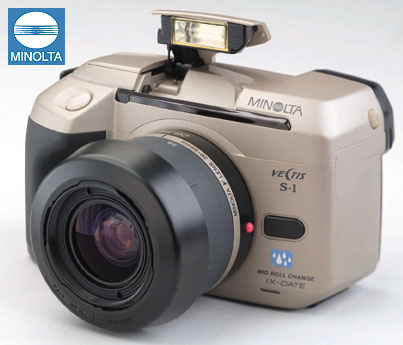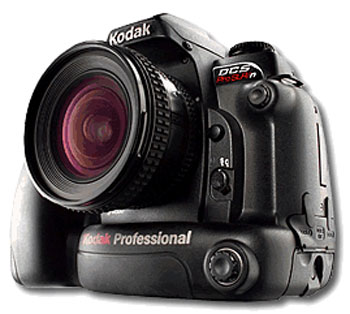The Digital Sensor: A Guide to Understanding Digital Cameras
by Wesley Fink on April 21, 2008 1:00 AM EST- Posted in
- Digital Camera
Why All these Different Sensor Sizes?
35mm first appeared on the scene in the 1930s and the film format simply took 35mm motion picture film and spooled it into a light-tight canister. By the 1960s, with point-and-shoot and developments in SLR technology, 35mm had become king of the film formats. Even as film manufacturers tried to introduce other film formats, 35mm continued to grow and prosper.
The SLR evolved in 35mm space and the world appeared orderly on the surface, but the only real constant was the size of the film. It was 35mm, but SLR manufacturers each championed their own lens mount and their exclusive lens line for their SLR film cameras. The primary advantage of the SLR was the ability to look through a wide variety of interchangeable lenses, and to accurately focus, meter, and later auto-focus through the viewing lens. As in today's digital SLR market, each manufacturer had their own lens mount, and lenses developed for one mount would not fit and work on others, i.e. a Nikon lens would not fit or work on a Canon camera.
APS (Advanced Photo System)
With the very early developments in digital photography, Kodak, Fuji, and others saw the handwriting on the wall for film photography. One of the ongoing complaints about 35mm film, however, has been that the 2:3 image format required image loss in almost every standard print size. Neither 8x10 nor 5x7 is a 2:3 ratio and both required cropping of the 35mm negative.

In 1996 a new APS (Advanced Photo System) initiative by Kodak, Fujifilm, Minolta, Nikon, Canon, and others was introduced to save film by standardizing on new ratios and adding new "computer-like" data storage capabilities in the taking and processing of film images. APS included a new film size - 30.2mm x 16.7mm - that could be printed full-frame (H or HDTV format), or use standard crops of 25.1mm x 16.7mm (C or Classic 2:3 format) or 9.5mm x 30.2mm (P or Panorama). Actually, the image size that was always shot was the 30.2mm x 16.7mm, and the other sizes were just standard crops.

The industry was confident they could sell APS, which in the most common C view was only about 55% of the already small 35mm size. Some manufacturers like Minolta developed new APS lens lines with smaller cameras and lenses, and Canon and Nikon developed APS camera bodies that could mount their regular lenses - and a few custom APS lenses.

In the end, APS failed in the film market. Industry pundits generally say APS failed because the negative was just too small, but it is more likely that it failed because it was just too late. Digital was on the near horizon, and many photographers did embrace smaller digital sensors while they rejected the smaller APS film format.
APS film is not that important in our discussion of digital photography, but the APS standard is important because it was also a standard for digital development. At the time of the APS initiatives, it seemed reasonable to aim for development of digital sensors for that same APS format, so lenses for both systems were interchangeable.
Most in the industry aimed for the APS C size sensor, which would be about 16.7mm x 25.1mm - the same ratio (2:3) as the classic 35mm format. Most manufacturers, burned by bad decisions in the APS film debacle, decided to keep their existing 35mm mounts, so their existing 35mm lenses could be used. They hedged their bets. This pleased current 35mm system owners, and camera makers could see if the new digital SLRs took hold. Once they were satisfied there was a market for digital SLR cameras, they could develop new lenses with a smaller image circle.

Canon and Nikon worked with Kodak in the early digital years to use their best film bodies with the current state-of-the-art Kodak sensors. These early DSLR cameras were incredibly expensive with massive power requirements and pro only. This development line culminated in the full-frame Kodak DCS Pro SLR/n and SLR/c. Those two cameras were the end of Kodak digital SLR cameras, although the company is still very active in the development and manufacture of digital imaging sensors and compact digital cameras.
Camera manufacturers introduced digital SLR products that revolved around the strength of their SLR business, the sensor capabilities they brought to manufacturing, and the relationships they had with other sensor manufacturers. Most of today's consumer DSLR cameras are based on sensors approximately APS C size, but they vary from the Olympus 4/3 sensor at 225mm² to the full-frame 35mm size with an area of 864mm².
Discussion of sensor size always tends to generate passionate discussion of the advantages of one manufacturer's sensor format over others, but please keep sensor sizes in perspective. The smallest 4/3 sensor still has 5.2x greater sensor area than the 43mm² sensor used in the 12MP Canon G9. The 4/3 sensor is 9x greater area than the common 1/2.5" compact sensor with an area of 25mm². Differences in digital SLR sensor size do matter, but they are very small compared to the difference in area between compact point and shoot digital sensors and today's digital SLR camera sensors.










72 Comments
View All Comments
gheinonen - Tuesday, October 14, 2008 - link
I am curious why that CMOS sensor in the high end Canon camera body has excellent low black noise compared to the images from a Fuji Pro S3/S5 with its Super CCD? I have used Fuji Pros since 2004 and have discovered that my black details in low light situations include a lot of random color noise which I do not see when reviewing images from the 1DS Mark2 body. What does the Canon body do to eliminate the random color noise in low light black detail? Is it the CMOS Sensor? Is it the body processing?Separately, the white detail on my Fuji Pro S3 has such expanded dynamic range that I can shoot higher exposures and then lower the exposure back to normal in software and it appears to lower or mask the noise floor in the same way that Dolby Noise Reduction works for audio.
bonedaddy - Wednesday, April 30, 2008 - link
I've been a 35 mm fan for years, and have a significant investment including multiple lenses, macro, ring lights etc. For trips etc the smaller cameras seemed fine--always had small 35 mm, for instance. However, re the digital small cameras, the amount of compression is really disappointing.Is my only choice to go back to a body/lens SLR if I want wide angle and telephoto capability AND good resolution?
Midwayman - Thursday, May 1, 2008 - link
No. But if you want wide/tele and really good high iso performance a SLR is where you need to be. PS camera have alway been a compromise. Small 35mm film cameras had focus issues, and lens issues too. Plus most people use iso 200-400 film which has reasonable quality even in a PS digital camera. The biggest difference is now we're blowing up the picture to 1:1 on our monitors and can see the quality defects easily. I bet if you printed your old compact photos at something like 16x20 you'd probably be unhappy with them too. That's the sort of scale we're looking at on our monitors zoomed in.CyniCat - Thursday, April 24, 2008 - link
Good article, but one glaring mistake: you claimed Sony was the first to make a 12+Mpixel CMOS sensor. I think you meant the first AFTER Canon - the 5D, with its 12.8Mpixel sensor, was on the market in 2005, and the 1Ds Mark II, with a 16Mp sensor, was on the market earlier than that.On a different front, I thought the Nikon D3 was using a Sony sensor, not a Nikon?
Wesley Fink - Friday, April 25, 2008 - link
The 5D and 1Ds II and III are full-frame sensors. The Sony was the first consumer (read affordable) APS-C sensor. Canon now has their own 12 megapixel consumer sensor in the XSi, which we are now reviewing.Nikon did their own designs for the D3 sensor, but they do not, to our knowledge, have the capabilities to manufacturer that sensor. Sony has manufactured sensors for them in the past and present with the D300, D60, D80, and others.
Since the new full-frame is CMOS it is likely manufactured by Sony, or possibley Samsung. Sony and Samsung (who make the Pentax 14.6 megapixel sensor) jointly own several patents on CMOS manufcaturing technology.
Wesley Fink - Friday, April 25, 2008 - link
That should read the read "First consumer 12 megapixel APS-C sensor". As mentioned several times in the article Canon pioneered CMOS technology in a consumer DSLR with the Digital Rebel.Midwayman - Wednesday, April 23, 2008 - link
This article complete skips of fuji's fantastic super CCD technology. Its not really a traditional Bayar array, nor a foveon. True they don't produce a interchangeable lens SLR but they do make prosumer SLR's with their sensor. Also the very notable fuji f30 series cameras were made with this sensor. It was a true triumph in PS camera high iso usability.ElFenix - Thursday, April 24, 2008 - link
fuji makes interchangeable lens SLRs with Nikon F mounts.Midwayman - Friday, April 25, 2008 - link
Hell, then there is no excuse for it not to be included in this article. Especially when it quite clearly states there are no other sensor options at one point.Wesley Fink - Friday, April 25, 2008 - link
There will always be fans of one technology or another who feel slighted. I apologize for that, but Fuji is still basically a Bayer sensor with a differnt pixel shape. I have added the following to the Bayer vs. Foveon page to make Fuji fans a bit happier:"FujiFilm produces one current DSLR with a variant of Bayer technology. It is called the Fuji S5 Pro and is basically a Nikon D200 body with a Fuji Super CCD sensor. The Fuji S5 Pro uses the Nikon lens mount. The Super CCD still uses red, blue and geen pixels in the same standard Bayer ratios. However, the shape of the pixel is hexagonal rather than the squate or rectangular pixels in other Bayer arrays. In the latest version Fuji also added smaller photosites between the normal pixels to gather "dynamic range" data.
Fuji has updated the camera body from the S3 to the S5 in the past year, but the sensor has not been updated for more than 3 years. The current Super CCD is still a 6.3 megapixel sensor, but Fuji specifes it as a 12.3 megapixel due to the addition fo the tiny "brightness" pixels. Tests indicate the true resolution is more comparable to an 8 to 10 megapixel sensor from competitors. The Fuji sensor is still basically a Bayer sensor with a different shape for pixels."
We can probably now all argue whether the Fuji Super CCD is really a Bayer variant or not. It certainly appears that way to me, and as a CCD instead of a CMOS sensor it is need of a serious update if it is to continue as a player in the DSLR market.